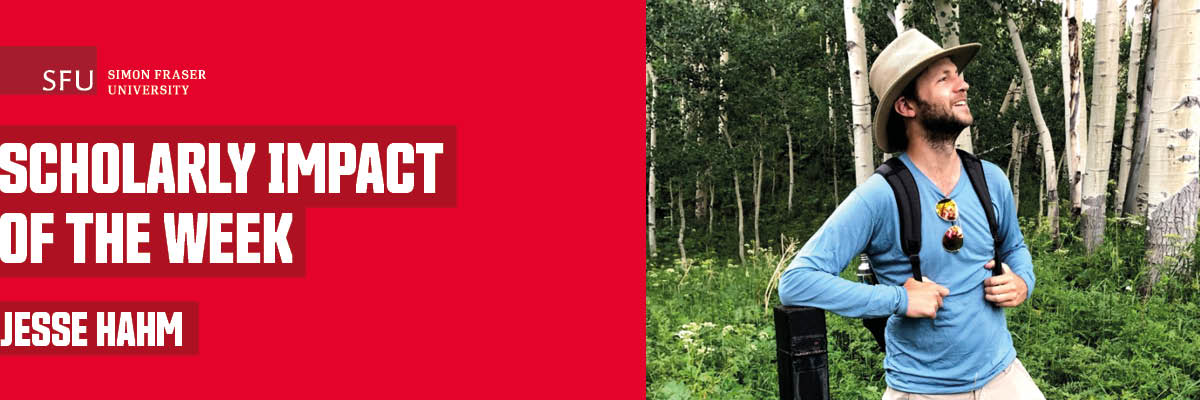
Mountainous regions like British Columbia receive much of their water supply from mountain snowpack—in fact, close to one quarter of the world’s population depends on melting snow. An improved understanding of how water behaves in times of abundance and of drought is crucial to the management of groundwater and watersheds in the province—and around the world.
Simon Fraser University (SFU) geography professor Jesse Hahm has researched diverse ecosystems in western North America, ranging from dry oak savannas to dewy rainforests. He has drilled into the bedrock to study the amount of water stored, and has explored factors that determine why forests thrive and how plants will respond to environmental change. He established the Hydrology Research Group at SFU which uses an interdisciplinary approach and integrates concepts from hydrology, geomorphology, and plant ecophysiology.
Hahm is also a Principal Investigator on Drought and Deluge: Informed Water Allocation Decision Making in a World of Intensifying Hydrologic Extremes, a three-year project by the Pacific Institute for Climate Solutions in partnership with the B.C. Ministry of Forests. He is one of the many researchers at SFU contributing towards community-centred climate innovation.
Hahm and Dana Lapides, an SFU geography and U.S. Forest Service ORISE postdoctoral fellow, researched why the 2021 snowmelt runoff in California was 60 per cent lower than predicted by the state’s Department of Water Resources models. Using a newly developed, updated water supply forecasting model that considers factors such as water storage deficits in soil and bedrock, Lapides led a study of 15 sites across the California Sierra Nevada. The study included large water supply basins such as the Merced River. It confirmed that drought had caused a deep, previously unmapped water deficit in the root-zone below soils into bedrock, resulting in unexpectedly low streamflow from the snowpack. The updated model significantly improves the accuracy of water supply forecasts following drought and is a vital tool to help communities predict and prepare for water scarcity.
The study, Causes of Missing Snowmelt Following Drought, a collaboration between researchers at the U.S. Forest Service Pacific Southwest Research Station, the University of Texas at Austin and SFU, was published in Geophysical Research Letters.
We spoke with professor Hahm about his research.
What was missing from the predictions of snowmelt and runoff in the Sierra Nevada?
Each year the spring streamflow from snowmelt can normally be predicted from the amount of snowpack in the mountains. In 2021, however, this historic relationship broke—much less streamflow arrived than was predicted for the snowpack. There are many possible reasons for this mysterious reduction in streamflow, but we found that plants had dried out the subsurface more—and deeper—than usual during the preceding drought years. We introduced to the snowmelt prediction calculations a way of accounting for this many metres deep drying of weathered bedrock by trees, and a way to quantify how the deep dry-down can grow over multiple years of drought.
Tell us about the methods used. How do you determine the amount of water that is historically stored in the bedrock root-zone?
We have field sites where we have installed boreholes into the bedrock that enable us to drop geophysical instruments that measure the amount of water stored in fractures that roots can access. In this study, we used remote satellite-sensed measurements of plant water use so that we could observe larger areas. Over the summer dry period, if trees use more water than is known to be stored in soils then we can infer that they must be supplementing their supply with deeper water, from the underlying weathered bedrock.
Does the water scarcity in California foreshadow what could happen in B.C.?
Definitely—it is getting warmer, and many climate models also predict that southwestern B.C. is going to become more ‘Mediterranean’ which means even drier summer periods like the climate further south along the West Coast. Year-to-year variability in wet season precipitation is also expected to increase—meaning wetter wet years and drier dry years.
California and B.C. experienced major flooding recently. Does that not replenish the subsurface water needed by plants?
It depends. In general, yes: big atmospheric rivers during the wet season help to replenish subsurface water storage deficits generated during the previous dry seasons. However, there are some relatively dry places where the deficits are so large, and where typical winter precipitation amounts are so low, that it can take a couple of years of higher than normal precipitation to replenish the subsurface storage used by forests.
Bonus question: What do you love most about your work?
I would have to say one of the best parts of my job is the amazing—and fun—colleagues that I work with.
Read more: Scientists dig deep and find a way to accurately predict snowmelt after droughts
Research funding was provided by a Natural Sciences and Engineering Research Council of Canada Discovery Grant, the Canada Foundation for Innovation, and the USDA Forest Service Pacific Southwest Research Station.
SFU's Scholarly Impact of the Week series does not reflect the opinions or viewpoints of the university, but those of the scholars. The timing of articles in the series is chosen weeks or months in advance, based on a published set of criteria. Any correspondence with university or world events at the time of publication is purely coincidental.
For more information, please see SFU's Code of Faculty Ethics and Responsibilities and the statement on academic freedom.